Last updated on January 17, 2017
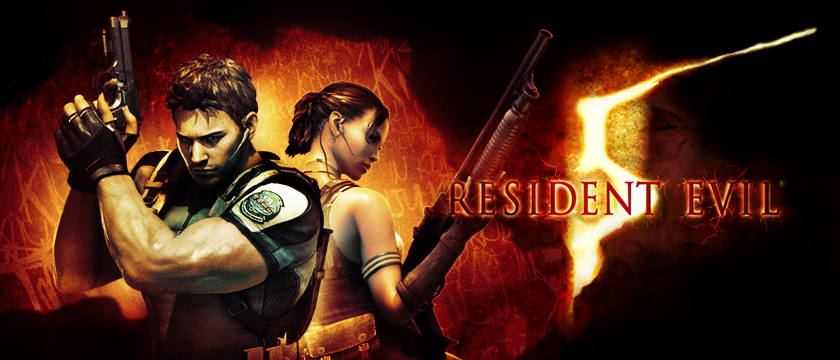
Video games like Resident Evil 5 often confuse via a mixture of branding and expectation. How does a (mostly) fresh new development team deal with the burden of creating a follow-up to one of 2004’s most revered games, Resident Evil 4? Do you simply try to add more, make it “bigger and better”, as most video game sequels tend to do? Should you strive to set the game in a completely new environment, hopefully distancing the sequel from its predecessor in aesthetics and thereby avoid a direct comparison? What exactly do you do? Well, apparently, you do whatever Resident Evil 5 did, since it’s the best-selling Resident Evil game of all time and the best-selling Capcom game of all time!
Surprised? Yeah, I was too. Despite the claims that Resident Evil wandered far from its roots, it appears the 4th game’s renovation of the survival horror series turned a lot of heads. But, that didn’t increase the series’ cachet among the general public as much as you might think. Despite tons and tons of re-releases, both RE5 and RE6 still beat RE4 from a pure sales perspective. I would wager that Shinji Mikami’s work hews more closely to the “Biohazard” model, but it that really what people wanted? Apparently not!
I suppose there’s at least one reason why Resident Evil 5 sold so well: co-operative play. Circa 2009, playing with a friend over the Internet became all the rage in the console realm – Gears of War popularized the model, and then every game with a modicum of shooting thereafter also needed to have it. But that doesn’t mean every game with co-op turned out to provide an engaging experience designed for two people. You can certainly shove two players into nearly any first or third-person shooter campaign, and you’ll wring some fun out of the basic shooting mechanics. But, it takes a lot more work to require two people to play a game in order to experience it in the correct way.
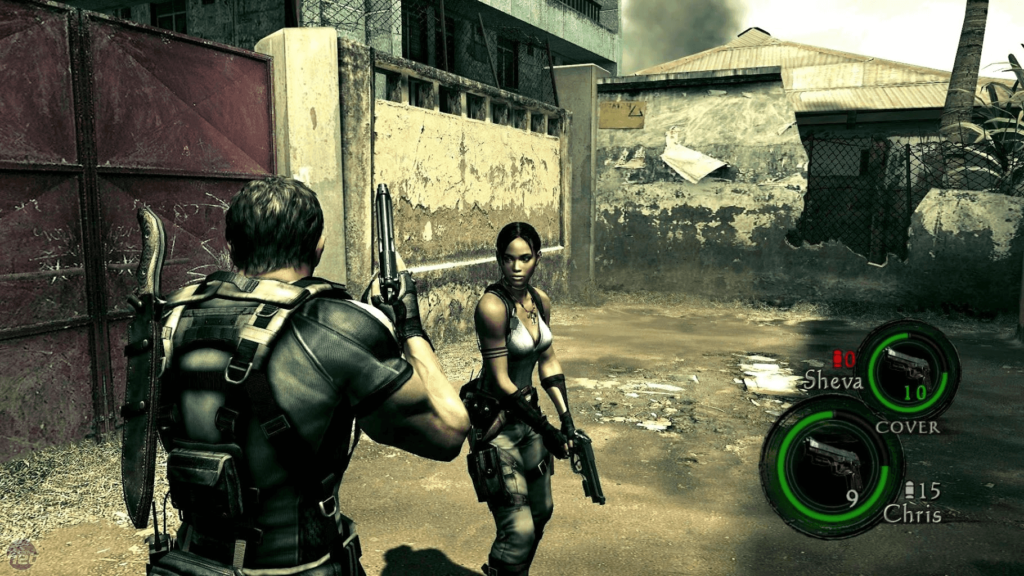
I can say this fundamentally changed my view of Resident Evil 5, to say the least. Playing the game in single-player feels like an exercise in drudgery. Granted, the game itself still plays a lot like the previous title, but so many situations require two people to cover each others backs. Having an AI pack mule (yeah, that seems accurate) who occasionally does stupid things does not work that well, especially on higher difficulty settings. I imagine someone out there disagrees. To those people, I say: get a friend, or a random Internet stranger, to play the game with you – it’ll beat the AI any day.
Before I get too far off course, let me describe what’s unique about Resident Evil 4-6: they transplant the pre-rendered backgrounds model of the previous games in the series into a third person shooter, simply via changing the camera angle. The earlier games use what are called “tank controls” – that is, a control scheme that works regardless of the camera angle. You press up to move forward, down to move backward, and left/right to turn. This sounds fairly unwieldy, but it allowed for more diverse level design. Early 3D games often provided boring, drab environments – the limitations of basic polygons became apparent fairly early, and lots of developers sought to change how players would perceive an environment.
One particularly popular solution came from the illusion of 3D spaces in the form of pre-rendered backgrounds made from either 3D images or sprites. You could create an imaginative environment, place the camera at a certain perspective dictated by that background, and go hog-wild with cool designs that were probably impossible to render into three dimensional polygons at the time. Resident Evil’s original release took advantage of this technique, and thus “tank controls” came into being to allow for that sort of design.
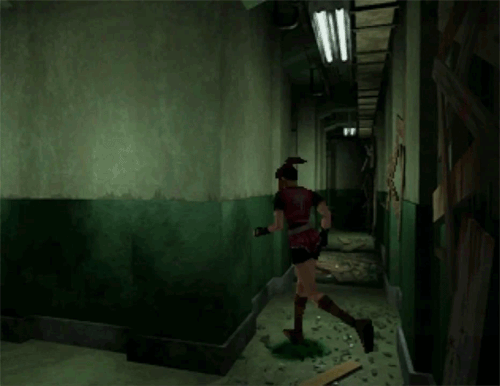
A lot of people complain about the inability to move in a horror game, as if it were a deficit in design. Quite the contrary – an unfamiliar, difficult control scheme adds to the tension of the game, especially in a high-pressure situations. Being required to think on the fly with tank controls proves a fun prospect precisely because it puts the “horror” in “survival horror” – it’s as much a part of the atmosphere as other elements of the game. An unfamiliar space with cinematic camera angles and an inability to move puts you right in the action. For 1995, you can imagine Resident Evil turned some heads!
And, adding to that horror element, the one thing that really defined Resident Evil as an excellent game comes from its emphasis on resource management. Adding to the “horror” element comes the “item” management – you can only hold so many items, from weapons to guns to ammo to health powerups to keys. Each of these items takes up a precious inventory slot, so you can’t just accrue items endlessly – you needed to think about what you were going to need in any up-and-coming encounter, journey, or stretch. Heck, the original game (and REmake) even forced you to carry items that would allow you to save, all of which were limited in quantity! That’s yet another element to add into the “survival horror” recipe. You were meant to run past enemies and figure out when you needed to use precious ammo to remove a tricky enemy. And enemies moved very, very slowly. Most of them are more like puzzles (of which there are many) rather than “enemies” in the traditional sense. You figure out what you need to do to kill them, if absolutely necessary, but avoiding them often proved the better way.
Honestly speaking, what makes Resident Evil 4 so interesting remains in its adherence to that same formula in so many ways – and yet, the few minor changes it appends to that formula change the game’s level design dramatically. The switch to a third-person camera made for a more intense experience, focused upon combat situations – that meant more ammo, but also more enemies! You still have to stop to aim, which makes shooting anything at all a commitment to a certain direction. Watch out for attacks from behind! Precision aiming with limited resources, rather than trying to avoid encounters, became the new modus operandi, and that made for a compelling new game type within an old shell.
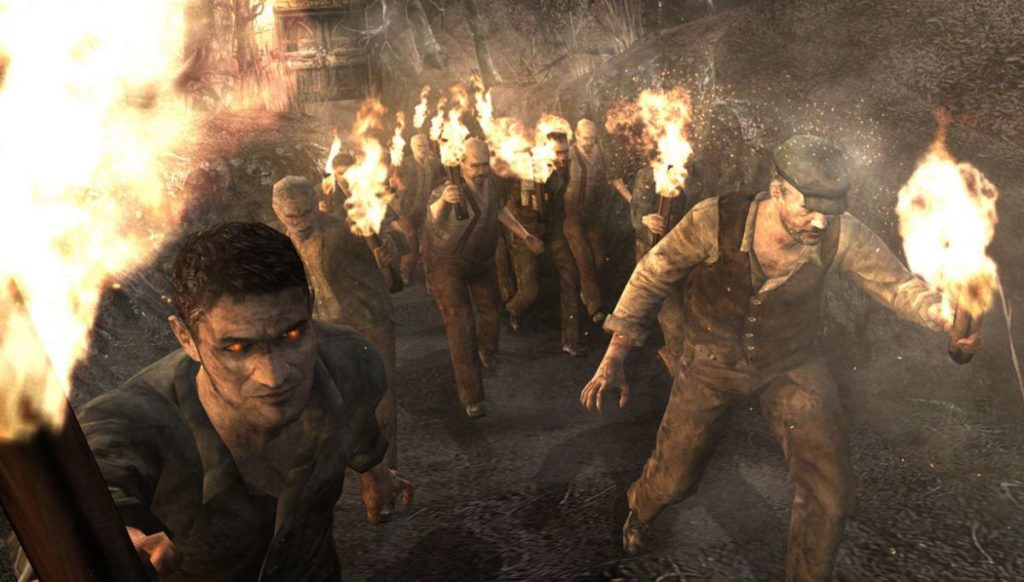
Enemies became smarter, more interesting, and more varied due to the three dimensional aiming model which encouraged aiming at specific body parts. Weapons became more varied, because each had a different nuanced that proved useful for certain encounters. And yet, the scarce resources remained, so upgrading weapons (a new feature) proved to become an important decision! As a pure game, Resident Evil 4 made the core formula a lot more accessible and interesting.
So, really, Resident Evil 5 doesn’t depart all that much from the Resident Evil formula, and doesn’t stretch very far from its immediate predecessor – it just adds a friend to the proceedings! Because of this change, more enemies needed to be added, and more combat situations needed to arise that require two people to solve. Some enemies act like little puzzles to figure out their weak point, whether it’s a glowing sac or simply actual fire (you know, the hot kind). One person might need to lead an enemy or boss around an arena, while the other sets up a proximity mine. There’s a lot of situations in Resident Evil 5 that force co-operation, and the formula of the series adapts perfectly to this new change in many instances.
Remember, your camera angle is still limited to the over-the-shoulder view. That means the game can throw a lot more enemies at your from unorthodox angles – hence, your partner can call out enemies attacking you from behind, or force an enemy to release their grip on you. Further, now necessary items can be share among two people so that the group can cover multiple specializations – I chose the handgun, rifle, and grenade launcher on my run, while my partner covered the shotgun, machine gun, and magnum. You can tell a game is designed well when the two partners get different ability and share part of the labor in solving the particular problems of a level segment. Most co-op games simply don’t present you with this sort of reliance on your partner to do equally heavy lifting, and for that Resident Evil 5 deserves some gold stars.
Of course, we could level the complaint that Resident Evil 5 isn’t particularly scary – not by a long shot – but that did not affect my enjoyment of the game at all. If we were to grade Biohazard games as horror movies, I think we’d put them on the low end of the “scary” scale anyways, and definitely sitting in the “B-movie camp” section of your local video rental store (if those existed anymore…I am old). The cheesiness has always been a part of Resident Evil’s charm, intentional or not, and Resident Evil 5 certainly has this in spade. Hard to beat “motorcycle zombie” for dumbest, yet most excellent concept in a video game (or having a guy repeatedly punching a rock, which causes it to move).
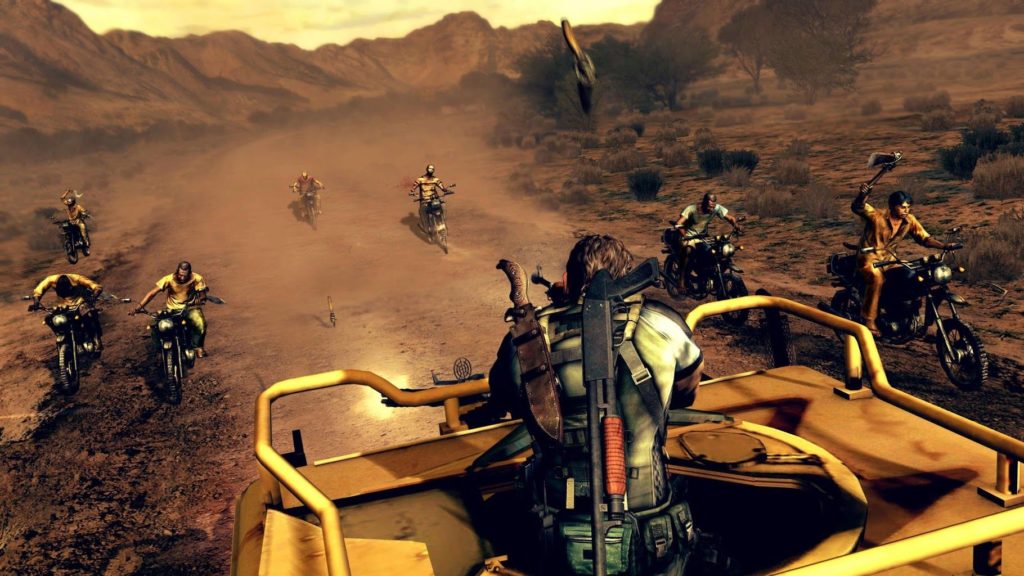
Resident Evil 5 nails that perfect balance of taking itself seriously, while also being a dumb video game with video game-like things at the same time. It’s part of why it holds up so well, despite being nearly a decade old at this point. The series never really strove for “high art” status, nor does it really want to be “the best game ever”. Sometimes, a game is just a game, and it’s pleasant to play, and doesn’t have pretension to be meaningful.
I suppose my gaming habits skew towards games like that more often than not. That’s because I don’t like to pine for things that don’t actually exist. What’s the best part about video games: that they offer you an experience full of “meaning” that changes your worldview, or that the game design elements combine perfectly to form a one-of-a-kind, and consistent, video game rule set that’s challenging and interesting? Only the latter truly takes advantage of being a “video game”, with the former being a nice aesthetic complement – a neat thing, all the same, but not the thing in itself.
But when we look for that sign, that somehow signifies “THIS IS SPECIAL”, we miss how much is there right in front of us. We’ll never be satisfied. And in the end, that’s exactly what Jesus means here in Luke 7 – there’s always some label we could put on something, a higher aspiration that prevents us from enjoying what’s in front of us.
31 Jesus went on to say, “To what, then, can I compare the people of this generation? What are they like? 32 They are like children sitting in the marketplace and calling out to each other:
“‘We played the pipe for you,
and you did not dance;
we sang a dirge,
and you did not cry.’33 For John the Baptist came neither eating bread nor drinking wine, and you say, ‘He has a demon.’ 34 The Son of Man came eating and drinking, and you say, ‘Here is a glutton and a drunkard, a friend of tax collectors and sinners.’ 35 But wisdom is proved right by all her children.”
Luke 7
I can certainly understand why someone might not like Resident Evil 5, whether that be series expectations or simply a boredom with the whole concept of third person cooperative multiplayer games. Maybe that even comes from how it is so dumb in concept and in plot, but that doesn’t diminish the quality of the game at all. It’s a solid, enjoyable shooter with just enough of Resident Evil 4 to make for engaging, unique gunplay. Add a friend, and you’ve really got something!
